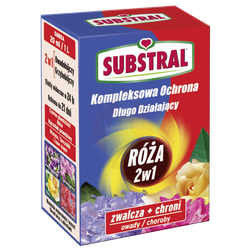- Substral Flowers Comprehensive Protection 2in1. A unique fungicide and insecticide for roses, rhododendrons, flowering shrubs. It works superficially, deeply and systematically - it fights insects and protects against diseases at the same time.
Substral Flowers Comprehensive Protection 2in1. A unique fungicide and insecticide for roses, rhododendrons, flowering shrubs. It works superficially, deeply and systematically - it fights insects and protects against diseases at the same time. The agent works: fungicidal, combating black spot, rust and powdery mildew. Insecticidal, fighting aphids (green and black) and other sucking insects.
Advantages:
- 2in1: fungicide and insecticide
- quickly visible effects
- protects for 21 days
Characteristic:
Substral Flowers Comprehensive Protection 2in1, which is both an insecticide and a fungicide, the preparation is a fungicide and insecticide in the form of a concentrate for the preparation of a water emulsion, with systemic action used in the preventive and interventional fight against fungal diseases, aphids and other insects that commonly attack amateur cultivation of ornamental plants (e.g. roses, bedding plants, ornamental shrubs). Flowers 2in1 Comprehensive Protection enables the gardener to act on all fronts of the fight - it works superficially, deeply and systematically on the plant. The agent is quickly taken up by the green parts of the plants and is moved along with the juices throughout the plant. Insects, feeding on the sap of the plant, die, even if they have not been sprayed directly. Rainfall, washing of the agent from the surface of plants and the influence of solar radiation are not significant in the case of a systemic agent. The agent does not leave dirty deposits on the leaves, and the effects of its use are noticeable after 24 hours. The product protects the entire plant against secondary infections and aphid raids. For roses, long-term protection can last for 21 days continuously. The preparation prevents deformation of leaves and has a positive effect on the coloring and growth of plants.
Content of active substances:
triticonazole - (fungicide from the group of conazolitriazoles) - 7.5 g in 1 liter of the agent (0.781%),
acetamiprid - (an insecticide from the group of neonicotinoids) - 2.5 g in 1 liter of the agent (0.262%).
Use:
Spray the plants in such a way as to thoroughly cover the upper and lower parts of the leaves with the liquid, avoiding dripping.
Deadline for use: Apply the agent after the appearance of the first symptoms of disease or signs of pest presence. If necessary, perform subsequent treatments regularly every 3 - 4 weeks, when the plant is affected by disease or infested with aphids, spray every 2 weeks. Use the measure until the end of September. In the protection of roses against black spot, the agent can be used from April. In a situation where the disease heavily infected the plants in the previous year, treatments should be started early, as soon as buds and leaves appear. The maximum number of treatments in the growing season - 4. The interval between treatments - at least 14 days.
Comments:
Spray the plant, making sure that both the lower and upper parts of the leaves are wet. Avoid direct spraying of flowers.
Spray during good weather conditions, avoiding harsh sunlight, drought and frost.
Before applying the agent to a larger or particularly valuable collection of ornamental plants, perform a trial treatment on each cultivated variety to check whether there has been any damage to the plants.
Do not use the agent in high winds, in full sun, during drought and after and during frosts, as well as before expected frosts.
In the case of thrips and spider mites, the product has a moderate level of control or reduces the presence of pests.
If there are resistant forms in the population of insects (especially aphids), the product may not be fully effective.
Dangerous for bees. To protect bees and other pollinating insects, do not use the agent during the honeymoon period and when flowering weeds are present.
In order to minimize the adverse effect on bees, it is recommended to use the agent in the morning or evening. 9. Do not allow the agent to get onto other consumption plants, e.g. vegetables.
The period from the application of the agent to the day when people and animals can enter the area where the agent was applied (prevention period): do not enter until the spray liquid is completely dry on the surface of the plants.
The period from the last application of the agent to the day of harvesting the crop (withdrawal period): not applicable.
The period from the last application of the product on plants intended for feed until the day when animals can be fed with these plants (withdrawal period for feed): not applicable.
The period from the last application of the product to the day when successive crops can be sown or planted: not applicable.
Only persons over 18 years of age may use plant protection products.
Plant protection products should be used safely.
Read the label and product information before each use.





